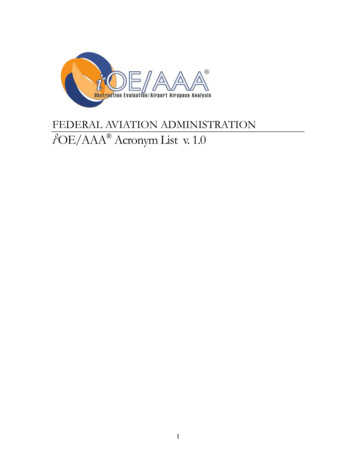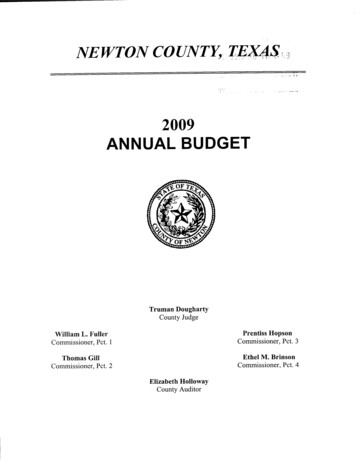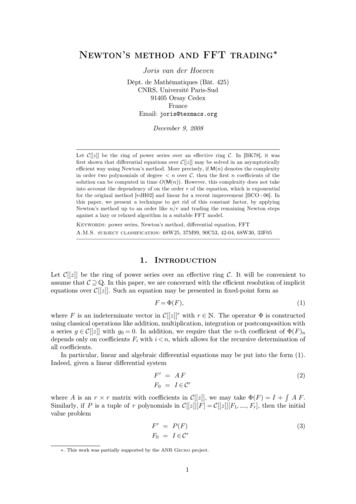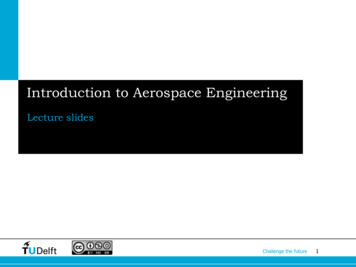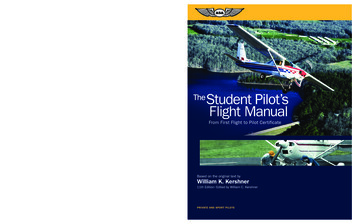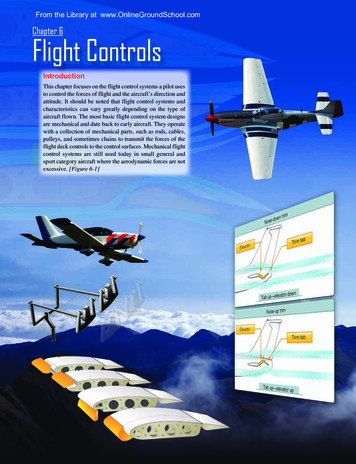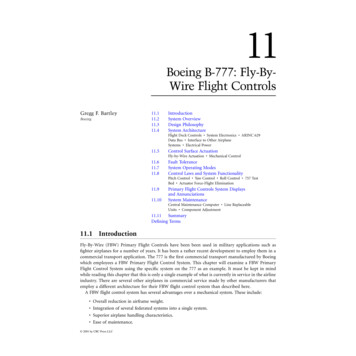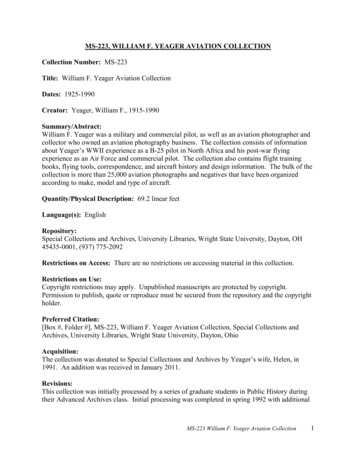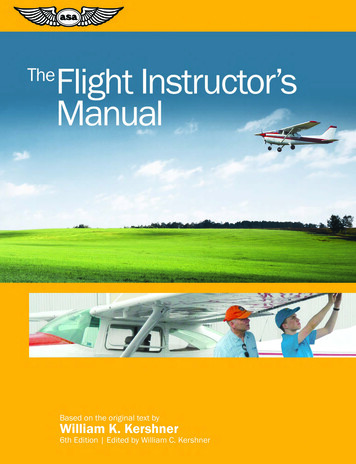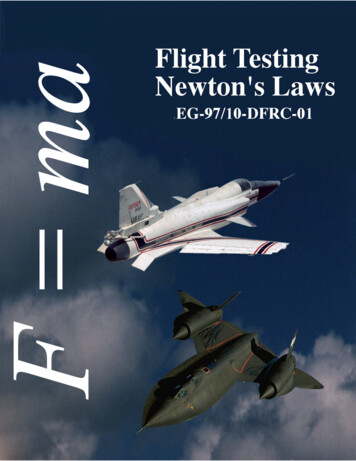
Transcription
Flight Testing Newton's LawsStudent's Flight ManualNASA / DFRC - X41 - 1
Flight Testing Newton's LawsStudent's Flight ManualTable of ContentsPagePreface - - - - - - - - - - - - - - - - - - - - - - - - - - - - - - - - - - - - - - - - - - - - - - - - - - - - - - - - - - - - - - - - iNational Science Education Standards - - - - - - - - - - - - - - - - - - - - - - - - - - - - - - - - - - - - iiCurriculum Standards for School Mathematics - - - - - - - - - - - - - - - - - - - - - - - - - - - iiReferences - - - - - - - - - - - - - - - - - - - - - - - - - - - - - - - - - - - - - - - - - - - - - - - - - - - - - - - - - - - - iiiAcknowledgments - - - - - - - - - - - - - - - - - - - - - - - - - - - - - - - - - - - - - - - - - - - - - - - - - - - - - iii1Review of Newton's Laws of Motion1.0 Importance of Physics - - - - - - - - - - - - - - - - - - - - - - - - - - - - - - - - - - - - - - 2.0 Newton's First Law - - - - - - - - - - - - - - - - - - - - - - - - - - - - - - - - - - - - - - - - - 3.0 Newton's Second Law - - - - - - - - - - - - - - - - - - - - - - - - - - - - - - - - - - - - - - 4.0 Newton's Third Law - - - - - - - - - - - - - - - - - - - - - - - - - - - - - - - - - - - - - - - - 5.0 Summary - - - - - - - - - - - - - - - - - - - - - - - - - - - - - - - - - - - - - - - - - - - - - - - - - 6.0 Measures of Performance - - - - - - - - - - - - - - - - - - - - - - - - - - - - - - - - - - - 7.0 Example - - - - - - - - - - - - - - - - - - - - - - - - - - - - - - - - - - - - - - - - - - - - - - - - - - 8.0 Suggested Activities - - - - - - - - - - - - - - - - - - - - - - - - - - - - - - - - - - - - - - - - Operational Supplement - - - - - - - - - - - - - - - - - - - - - - - - - - - - - - - - - - - - -1.11.21.21.41.51.51.51.51.62Weight and Balance1.0 Definitions - - - - - - - - - - - - - - - - - - - - - - - - - - - - - - - - - - - - - - - - - - - - - - - - 2.0 Balancing Forces and Moments - - - - - - - - - - - - - - - - - - - - - - - - - - - - - - 3.0 Significance of Weight & Balance - - - - - - - - - - - - - - - - - - - - - - - - - - - 4.0 Weighing An Aircraft - - - - - - - - - - - - - - - - - - - - - - - - - - - - - - - - - - - - - - 5.0 Measures of Performance - - - - - - - - - - - - - - - - - - - - - - - - - - - - - - - - - - - 6.0 Suggested Activity - - - - - - - - - - - - - - - - - - - - - - - - - - - - - - - - - - - - - - - - - Operational Supplement - - - - - - - - - - - - - - - - - - - - - - - - - - - - - - - - - - - - -2.12.12.22.32.62.62.73Developing Lift1.0 Definitions - - - - - - - - - - - - - - - - - - - - - - - - - - - - - - - - - - - - - - - - - - - - - - - - 2.0 Bernoulli's Equation - - - - - - - - - - - - - - - - - - - - - - - - - - - - - - - - - - - - - - - 3.0 Lift and the Rate of Change of Momentum - - - - - - - - - - - - - - - - - - - - 4.0 Lift and the Bernoulli Equation - - - - - - - - - - - - - - - - - - - - - - - - - - - - - - 5.0 Summary - - - - - - - - - - - - - - - - - - - - - - - - - - - - - - - - - - - - - - - - - - - - - - - - - 6.0 Measures of Performance - - - - - - - - - - - - - - - - - - - - - - - - - - - - - - - - - - - 7.0 Example - - - - - - - - - - - - - - - - - - - - - - - - - - - - - - - - - - - - - - - - - - - - - - - - - - 8.0 Suggested Activity - - - - - - - - - - - - - - - - - - - - - - - - - - - - - - - - - - - - - - - - - -3.13.13.23.43.53.53.53.64Developing Drag1.0 Definitions - - - - - - - - - - - - - - - - - - - - - - - - - - - - - - - - - - - - - - - - - - - - - - - - 2.0 Introduction - - - - - - - - - - - - - - - - - - - - - - - - - - - - - - - - - - - - - - - - - - - - - - - 3.0 Skin Friction - - - - - - - - - - - - - - - - - - - - - - - - - - - - - - - - - - - - - - - - - - - - - - 4.0 Pressure Drag - - - - - - - - - - - - - - - - - - - - - - - - - - - - - - - - - - - - - - - - - - - - - 4.1 Causes of Pressure Drag - - - - - - - - - - - - - - - - - - - - - - - - - - - - - - - 5.0 Summary - - - - - - - - - - - - - - - - - - - - - - - - - - - - - - - - - - - - - - - - - - - - - - - - - 6.0 Measures of Performance - - - - - - - - - - - - - - - - - - - - - - - - - - - - - - - - - - - 7.0 Suggested Activity - - - - - - - - - - - - - - - - - - - - - - - - - - - - - - - - - - - - - - - - - Operational Supplement - - - - - - - - - - - - - - - - - - - - - - - - - - - - - - - - - - - - -4.14.14.14.24.34.54.54.54.9
5678Thrust1.0 Definitions - - - - - - - - - - - - - - - - - - - - - - - - - - - - - - - - - - - - - - - - - - - - - - - - 2.0 Introduction - - - - - - - - - - - - - - - - - - - - - - - - - - - - - - - - - - - - - - - - - - - - - - - 3.0 Principles of Thrust - - - - - - - - - - - - - - - - - - - - - - - - - - - - - - - - - - - - - - - - 3.1 Propeller Aircraft - - - - - - - - - - - - - - - - - - - - - - - - - - - - - - - - - - - - - 3.2 Jet Engines - - - - - - - - - - - - - - - - - - - - - - - - - - - - - - - - - - - - - - - - - - - 4.0 Summary - - - - - - - - - - - - - - - - - - - - - - - - - - - - - - - - - - - - - - - - - - - - - - - - - 5.0 Measures of Performance - - - - - - - - - - - - - - - - - - - - - - - - - - - - - - - - - - - 6.0 Problems - - - - - - - - - - - - - - - - - - - - - - - - - - - - - - - - - - - - - - - - - - - - - - - - - - -5.15.15.15.15.35.55.55.5Takeoff Performance1.0 Definitions - - - - - - - - - - - - - - - - - - - - - - - - - - - - - - - - - - - - - - - - - - - - - - - - 2.0 Introduction - - - - - - - - - - - - - - - - - - - - - - - - - - - - - - - - - - - - - - - - - - - - - - - 3.0 Test Aircraft Description - - - - - - - - - - - - - - - - - - - - - - - - - - - - - - - - - - - 4.0 Determining the Takeoff Speed - - - - - - - - - - - - - - - - - - - - - - - - - - - - - - 5.0 Determining the Drag - - - - - - - - - - - - - - - - - - - - - - - - - - - - - - - - - - - - - - 6.0 Determining the Acceleration - - - - - - - - - - - - - - - - - - - - - - - - - - - - - - - 7.0 Determining the Takeoff Distance - - - - - - - - - - - - - - - - - - - - - - - - - - - 8.0 Rolling Friction - - - - - - - - - - - - - - - - - - - - - - - - - - - - - - - - - - - - - - - - - - - - 9.0 Summary - - - - - - - - - - - - - - - - - - - - - - - - - - - - - - - - - - - - - - - - - - - - - - - - - 10.0 Measures of Performance - - - - - - - - - - - - - - - - - - - - - - - - - - - - - - - - - - - 11.0 Example - - - - - - - - - - - - - - - - - - - - - - - - - - - - - - - - - - - - - - - - - - - - - - - - - - -6.16.16.16.16.26.26.36.36.46.56.5Climb and Descent Performance1.0 Definitions - - - - - - - - - - - - - - - - - - - - - - - - - - - - - - - - - - - - - - - - - - - - - - - - 2.0 Introduction - - - - - - - - - - - - - - - - - - - - - - - - - - - - - - - - - - - - - - - - - - - - - - - 3.0 Theory - - - - - - - - - - - - - - - - - - - - - - - - - - - - - - - - - - - - - - - - - - - - - - - - - - - 3.1 Simplifying Assumptions - - - - - - - - - - - - - - - - - - - - - - - - - - - - - - 3.2 Climb Rate vs Velocity - - - - - - - - - - - - - - - - - - - - - - - - - - - - - - - - 4.0 Power Method - - - - - - - - - - - - - - - - - - - - - - - - - - - - - - - - - - - - - - - - - - - - - 5.0 Energy Method for Climb Performance - - - - - - - - - - - - - - - - - - - - - - - 6.0 Data Analysis - - - - - - - - - - - - - - - - - - - - - - - - - - - - - - - - - - - - - - - - - - - - - 7.0 Descents - - - - - - - - - - - - - - - - - - - - - - - - - - - - - - - - - - - - - - - - - - - - - - - - - - 8.0 Summary - - - - - - - - - - - - - - - - - - - - - - - - - - - - - - - - - - - - - - - - - - - - - - - - - 9.0 Measures of Performance - - - - - - - - - - - - - - - - - - - - - - - - - - - - - - - - - - - -7.17.17.17.17.37.37.47.47.57.57.5Cruise Performance1.0 Definitions - - - - - - - - - - - - - - - - - - - - - - - - - - - - - - - - - - - - - - - - - - - - - - - - 2.0 Introduction - - - - - - - - - - - - - - - - - - - - - - - - - - - - - - - - - - - - - - - - - - - - - - - 3.0 What is Range Performance? - - - - - - - - - - - - - - - - - - - - - - - - - - - - - - - - 4.0 Determining the Maximum Endurance Airspeed - - - - - - - - - - - - - - - 5.0 Determining the Maximum Range Airspeed - - - - - - - - - - - - - - - - - - - 6.0 How to Keep the Cruise Speed High - - - - - - - - - - - - - - - - - - - - - - - - - - 7.0 Flight Testing Cruise Performance - - - - - - - - - - - - - - - - - - - - - - - - - - - 8.0 Summary - - - - - - - - - - - - - - - - - - - - - - - - - - - - - - - - - - - - - - - - - - - - - - - - - 9.0 Measures of Performance - - - - - - - - - - - - - - - - - - - - - - - - - - - - - - - - - - - 10.0 Problems - - - - - - - - - - - - - - - - - - - - - - - - - - - - - - - - - - - - - - - - - - - - - - - - - - -8.18.18.18.28.58.68.68.78.78.7
910Landing1.0 Definitions - - - - - - - - - - - - - - - - - - - - - - - - - - - - - - - - - - - - - - - - - - - 2.0 Introduction - - - - - - - - - - - - - - - - - - - - - - - - - - - - - - - - - - - - - - - - - - 3.0 Theory - - - - - - - - - - - - - - - - - - - - - - - - - - - - - - - - - - - - - - - - - - - - - - 3.1 Descents - - - - - - - - - - - - - - - - - - - - - - - - - - - - - - - - - - - - - - - - 3.2 Approach - - - - - - - - - - - - - - - - - - - - - - - - - - - - - - - - - - - - - - - 3.3 Flare - - - - - - - - - - - - - - - - - - - - - - - - - - - - - - - - - - - - - - - - - - - 3.4 Rollout - - - - - - - - - - - - - - - - - - - - - - - - - - - - - - - - - - - - - - - - - 4.0 Summary - - - - - - - - - - - - - - - - - - - - - - - - - - - - - - - - - - - - - - - - - - - - 5.0 Measures of Performance - - - - - - - - - - - - - - - - - - - - - - - - - - - - - - - 6.0 Suggested Activities - - - - - - - - - - - - - - - - - - - - - - - - - - - - - - - - - - - -9.19.19.19.19.29.39.49.69.69.7Summary and Review1.0 Introduction - - - - - - - - - - - - - - - - - - - - - - - - - - - - - - - - - - - - - - - - - - - 10.12.0 Weight and Balance of the Model - - - - - - - - - - - - - - - - - - - - - - - - - - 10.13.0 Determining Thrust of the Model - - - - - - - - - - - - - - - - - - - - - - - - - - 10.24.0 Determining Takeoff Speed - - - - - - - - - - - - - - - - - - - - - - - - - - - - - - 10.25.0 Determining the Drag - - - - - - - - - - - - - - - - - - - - - - - - - - - - - - - - - - - 10.36.0 Determining the Acceleration - - - - - - - - - - - - - - - - - - - - - - - - - - - - - 10.37.0 Determining Takeoff Distance - - - - - - - - - - - - - - - - - - - - - - - - - - - 10.48.0 Conclusion - - - - - - - - - - - - - - - - - - - - - - - - - - - - - - - - - - - - - - - - - - - - 10.5
PrefaceThe "Flight Testing Newton ’s Laws" NASA Education Series uses aircraft to stimulate thestudent’s interest in the physical sciences and mathematics. The main emphasis lies in showing howNewton’s three laws of motion apply to flight testing an aircraft. However, complementary areas oftrigonometry, vector addition, weight and balance, along with resolution of forces are also employed.Following a brief review in the first video of Newton ’s Three Laws and the four basic forces of flight, thepresentation follows the typical sequence employed by test pilots and engineers preparing for a test flight.Aircraft weight and balance, determining takeoff distance, cruise performance, and landing distance areaddressed in turn.Each lesson guide is presented in the format of a Flight Instructor’s Manual used by aircraftmanufactures and pilots. This Manual contains certain areas where the teacher should direct the student’sattention. Each of these areas are identified by their relative importance according to the following criteria:NOTE:Sidelight information which may add to ensuing discussions but which is not consideredessential to the material content.Caution:Should the student fail to consider a particular aspect of the topic of discussion, theresult may be the wrong answer to the example problem.Warning:This block will identify background information the student should already possess.Knowledge of identified concepts is essential to understanding the material beingpresented. The material is not given during this session but is identified to theinstructorin order to permit discussion of the material prior to undertaking the current lesson.By way of example, consider the following:NOTE:In an actual Pilot ’s Flight Manual, the Notes, Cautions, and Warnings are defined asfollows:NOTE:An operating procedures, techniques, etc., which is considered essential toemphasize.Caution:Operating procedures, techniques, etc., which could result in damage toequipment if not carefully followed.Warning:Operating procedures, techniques, etc., which couldinjury or loss of life if not carefully followed.result in personalOften information that is not critical to flight safety, but which enhances the pilot’s understanding,is provided in the form of an Operational Supplement. Throughout this manual, Operational Supplementsare provided at the end of the session to enhance the understanding of the material. When appropriate, anote is added to direct the reader's attention to the end of session Operational Supplement.All units in the Flight Instructor ’s Manual are presented in the English system. The rationalebehind this is twofold . First, engineers and pilots in the United States still use the English systemexclusively. All cockpits have instrumentation measured in feet, statue or nautical miles per hour, poundsper square inch, and foot-pounds. Second, it is felt that if so desired, by converting the example problemsi
into the metric system, the student will develop a feel for the relative magnitudes of units between the twosystems. The accompanying text often presents both sets of units in its examples and explanations.Occasionally, the teacher may want to stop the video to reinforce or clarify subjects beingpresented. Throughout this guide, there will be areas annotated by**STOP VIDEO** where clarificationmay be appropriate. In addition, where definitions are presented at the beginning of the session, it may beadvantageous to review the definitions before showing the video. The recommended areas to start thevideo are annotated with **START VIDEO**. All material presented prior to the **START VIDEO**symbol should be covered before hand.The National Aeronautics and Space Administration's Education Division supports the NationalEducation Standards. The activities in Flight Testing Newton's Laws were developed in accordance withthe National Education Standards and satisfy the content requirements for science and mathematicsspecified below:National Science Education StandardsPhysical ScienceMotions and Forces: Objects change their motion only when a net force is applied. Laws of motion are used to calculateprecisely the effects of forces on the motion of objects. The magnitude of the change in motion canbe calculated using the relationship F ma , which is independent of the nature of the force.Whenever one object exerts force on another, a force equal in magnitude and opposite in directionis exerted on the first object.Gravitation is a universal force that each mass exerts on any other mass. The strength of thegravitation attractive force between two masses is proportional to the masses and inverselyproportional to the square of the distance between them.Curriculum Standards for School MathematicsMathematics as Problem Solving Use, with increasing confidence, problem-solving approaches to investigate and understandmathematical content.Apply integrated mathematical problem-solving strategies to solve problems from within andoutside mathematics.Mathematics as Communication Reflect upon and clarify their thinking about mathematical ideas and relationshipsRead written presentations of mathematics with understandingMathematics as Reasoning Make and test conjecturesMathematical Connections Relate procedures in one representation to procedures in an equivalent representationii
Use and value the connections between mathematical and other disciplinesAlgebra Represent situations that involve variable quantities with expressions, equations, inequalities, andmatrices;Operate on expressions and matrices, and solve equations and inequalities;Appreciate the power of mathematical abstraction and symbolism;Demonstrate technical facility with algebraic transformations, including techniques based on thetheory of equations.Functions Model real-world phenomena with a variety of functions.Trigonometry Explore periodic real-world phenomena using the sine and cosine functions;Solve trigonometric equations and verify trigonometric identitiesReferencesNRC (National Research Council). 1996.National Academy Press.National Science Education Standards.Washington, DC:National Council of Teachers of Mathematics. Commission on Standards for School Mathematics. 1989.Curriculum and Evaluation Standards for School Mathematics . Reston, Virginia: National Council ofTeachers of Mathematics.It is our intent that through the use of videos and Flight Manuals, the thrill of aviation can beenjoyed by both the student and the teacher.AcknowledgmentsEndeavors such as "Flight Testing Newton ’s Laws" require the efforts of numerous people. TheNASA/Dyden Flight Research Center’s Education Division and the National Test Pilot School staff wouldlike to extend a special thanks to the following individuals:Ms. Lauern Holen of the Tehachapi (CA) Unified School DistrictMr. Jim Nickel of the Antelope Valley (CA) Union High School DistrictMs. LeAnn B. Tichenor of Desert High, Edwards AFB, CAThe tireless support of these teachers in the review and trial presentations of the "Flight TestingNewton’s Laws" series is greatly appreciated.iii
Session 1Review of Newton's Laws of Motion1.0 Importance of PhysicsTesting airplanes requires pilots to know a lotmore than just how to fly the plane; they must alsoknow why an airplane flies. The science of flight istotally dependent upon physics. In fact, without agood understanding of physics, Orville and WilburWright would never have gotten their Flyer off theground.NOTE:The following types of aircraft are shown inthe first video:SAAB Draken(supersonic fighter)Aeromacchi Impala(jet trainer)Wright FlyerMany "would-be" aircraft designers never tookthe time to study Newton ’s Laws, and as a result,built contraptions that flew worse than they looked.Sikorsky S-55(transport helicopter)"Would-Be" DesignIn order to make effective use of Newton ’s Laws, abrief review of each is in order.Newton’s Laws of Physics are still applied byaircraft designers every day forevery type ofaircraft. Using these laws, designers are able todetermine such things as the overall shape of theaircraft, how many engines are required, how far itcan go, and how much runway is needed to takeoffand land. All these areas must be addressed for thedesign to be successful.Warning:The assumption is made that the students havealready been taught the development of Newton ’sLaws. The following presentations are meant toserve only as a refresher. Sections 5.1 thr ough 5.4of the accompanying text should be reviewed priorto starting the video.1.1
Session 1Review of Newton's Laws of Motion**START VIDEO**2.0 Newton’s First LawThe First Law of Motion is often referred to asthe Law of Inertia. The formal definition states:"A body in motion at a uniform speedwill remain in motion at that speed unlessacted upon by an external force, and abody at rest will remain at rest unlessacted upon by an external force."Sled Track Test SubjectNOTE:Each belt must be made of the proper materialand to the correct size to provide enough externalforce to limit the pilot ’s movement. Determiningthe size of forces is the topic of Newton ’s SecondLaw.See the Operational Supplement at the end of thissession for a description of speed and velocity.A body in motion is exactly what seatbelts aredesigned to restrain. Seatbelts are known to savelives by preventing the vehicle occupant fromcontinuing forward when the vehicle stopssuddenly. The tendency for the occupant tocontinue forward is a classic case of inertia atwork. The "external force" which acts upon thebody comes in the form of theseatbelt.NOTE:The rapid deceleration rate caused Col.Stapp’seyes to hemorrhage, giving him two completely redeyes.3.0 Newton’s Second LawNewton’s Second Law of Motion relates forceto acceleration. The formal definition is:"Force is equal to mass times acceleration,or F ma."NOTE:See the Operational Supplement at the end of thissession for discussion of acceleration.Seatbelts at WorkAn everyday example of this law occurs when westep on the scale to weigh ourselves.For the speeds experienced in a car, theseatbelts/shoulder strap combination shouldprovide sufficient stopping force for the occupant.However, since aircraft travel at much fasterspeeds and are free to move in three dimensions, a"five point" harness is often used; 2 shoulderstraps, a right and left seatbelt, and a "negative-g"strap between the legs. The effectiveness of thisarrangement can be seen on the sled trackoccupant.1.2
Session 1Review of Newton's Laws of MotionAs an aircraft maneuvers, the pilot experiencesa change in the "g-factor." This factor is multipliedtimes the standard gravitational acceleration of32.2 ft/sec2. A mathematical expression of thiswould look likeF maFw mg ("g" factor)Caution:Second Law at WorkThe " g" factor is actually a result of centripetalacceleration. The equation for this isThe force can be measured directly as ourweight, refered to as Fw. Additionally, on Earth,the acceleration of gravity is found to be 32.2ft/sec2. Substitution into the2F mVRHowever, for this application the "g" factor can beenvisioned as simply a multiplication factor.F ma,equation and rearranging wherea gExample: The pilot in the video weighs 155pounds. To determine his mass,Fwm gthis equation yields our mass.NOTE:Descriptions of this and other acceleration factorsare contained in the Operational Supplement.NOTE:The development of the universal gravitationalconstant is contained in the OperationalSupplement.Fw mg155 lbs m (32.2 ft/sec2)The significance of knowing our mass comes tolight when we are not subjected to the Earth’sgravity. A man standing on the Earth has the samemass as he would standing on the moon. However,on the moon he would weigh 1/6th of what hewould weigh on the Earth. The difference in hisweight comes from the differences in thegravitational acceleration constants between theEarth and the moon. The moon’s gravitationalacceleration is only 1/6th that of the Earth ’s. As aresult, his weight is only1/6th of his Earthlyweight. In aviation, the Earth’s gravitationalacceleration is referred to as a " g." Often times apilot may feel the effect of more (or less) than 1"g."thereforeorFwm g 155 lbs/32.2 ft/sec2m 4.8 slugs**STOP VIDEO after pilot talks aboutslugs**NOTE:The use of slugs as a unit of measurement may beforeign to some students. See page 4.2 of the textfor a complete definition of a slug and itsequivalent in the metric system.During a "2-g" turn, the pilot ’s weight can befound by:Fw mg("g" factor)1.3
Session 1Review of Newton's Laws of MotionFw (4.8 slugs) (32.2 feet/sec ) (2)Fw 309 pounds2NOTE:The mass actually comes out to 4.8137 slugs. Dueto round-off error, the 2 g turn results in 309 lbsinstead of the more exact 310 lbs.**START VIDEO**From this example, it can be seen that a " g"factor is purely a multiplication factor used todetermine an increase in weight. Since thisincrease in weight acts towards the pilot ’s feet, theforce may cause the blood to leave his upper bodycausing him to black out. As a result, he wears an"anti-g" suit to provide an opposing force on hislegs keeping the blood in his head and chest.Opposing forces is the subject of Newton ’ thirdlaw.4.0 Newton’s Third LawThe third law of motion is often thought of asthe law of action and reaction. Specifically it states"When one object exerts a force onanother, the second object must exert anequal and opposite force on the first."The simplest example of this is when we standfrom sitting in a chair. We place our feet on thefloor, use our legs to push against the floor, andpush ourselves up. If the earth, or floor, didn't pushback with an equal amount of force, we would fallinto the earth (earth pushing back with less force)or we would be propelled into the air (earthpushing back with more force). The same principleapplies to a jet engine. Thrust is the forceproduced by the hot gas coming out the back of theengine. Since Newton's third law must also beobeyed here, the air exerts a force equal to thethrust but in the opposite direction, propelling thejet forward in the same manner as the floorexerting a force on your legs allows you to stand.1.4Thrust is just one of four primary forces whichact upon an aircraft in flight. The plane can'tviolate the third law, therefore thrust must beopposed by an equal and opposite force. Thissecond force is called drag. Drag is the resistanceof the atmosphere to the aircraft, like you feel whenyou put your hand out the window of a moving car.When drag and thrust are equal, the aircraft is nolonger accelerating, but remains at the same speedsince these forces are equal. If thrust is increasedby adding more power, the aircraft will initiallyaccelerate to a new speed. However as the plane'sspeed increases, so does the drag and eventually,thrust and drag will again be equal, but at a fasterspeed.The remaining two forces on the aircrafthighlight how a plane stays in the air. Lift is theforce provided by the wings as the plane movesforward through the air. If lift is the force whichcauses a plane to rise, then it seems logical theopposing force would act in a downward direction.Not surprisingly, this force is the plane's weight.Now it may seem strange, but lift is always equalto weight, otherwise the aircraft couldn't stay in theair.The aircraft is controlled by changing the liftforces over the wings and tail. Moving the controlstick forward or backward causes more or less lifton the tail causing the nose to move up or down.Likewise moving the stick from side to side causesmore lift on one wing, which results in a roll.Forces in Flight
Session 1Review of Newton's Laws of MotionAll four of these forces are actually dependentupon each other and in a future session, theirinterrelationships will be explored.w mg155 pounds m (32.2 feet/sec2)m 4.8 slugs2. Again using the second law, at a "g" factor of 12, the force is now5.0 SummaryNewton's three laws were highlighted here toprovide the student with an exposure into only afew areas where the laws come into play inaviation. The pilot's restraint system reviewed theprinciple of inertia, the "g" factors emphasized thechange in force with a change in acceleration, whilethe jet engine and the forces of flight showed theconcept of action and reaction. All of these lawscan be demonstrated in the following example.What does Newton's first law state?2What does Newton's second law state?3What does Newton's third law state?4What is a "g"?5What is a "g" factor?w (4.8 slugs)(32.2 feet/sec2)(12)w 1855.7 pounds3. This total force can be divided among the seatbelts.Caution:One of the seatbelts is a "negative g" belt. Since thequestion states a "positive g-factor of 12" this beltshould not be included in the calculations.6.0 Measures of Performance1w mg ("g" factor)1855.7 pounds / 4 belts 463.7 pounds per belt4. Therefore each belt must be designed to be ableto provide an opposing force of 463.7 poundsto contain the pilot's inertia.NOTE:7.0 ExampleThe "negativeg" belt only provides an anchor pointfor the lap belt and shoulder belt. This anchorprevents the belts form slackening during negativeg maneuvers.Problem:The pilot in the video said he weighs 155 pounds.The restraint system in the aircraft consists of fiveseatbelts (two shoulder belts, two lap belts and onenegative "g" belt). How much force does each belthave to withstand to keep him from hitting theinstrument panel if he experiences a positive " g"factor of 12 when the plane comes to a rapid stopduring a crash landing?8.0 Suggested Activities1Have each student weigh themselves anddetermine their mass from the relationshipFw mgSolution:1. The pilot's mass is found by use of the secondlaw:Fm gwF ma2On Earth, one "g" is the acceleration of gravity(32.2 ft/sec2) and the force is equal to hisweight. Therefore, this mass is1.5Have each student determine how much theywould weigh during a 2g, 4g and 9g turn.
Session 1Review of Newton's Laws of MotionOperational SupplementSpeed and VelocityThe simplest kind of motion that an object can have is a uniform motion in a straight line. Thismeans an object moving in this manner is moving with a constant velocity. Constant velocity implies notonly constant speed, but, unchanging direction as well. For this reason velocity is a vector quantity.The speed of a moving body is the distance it moves per unit time in any arbitrary direction. If thespeed is uniform, the object moves an equal distance in each successive unit of time. Speed is a scalarmeasurement since the direction of motion is immaterial. Whether or not the speed is constant, theaveragespeed is the distance the body moves divided by the time required for the motion:s - sV avg t 2 - t 1 DsDt21(1)where Ds is the distance traveled, Vavg is the average speed, and Dt is the elasped time. The British systemunit of speed is the foot per second (ft/sec); the SI unit is the meter per second (m/sec); many other unitsare common, such as the mile per hour(mi/hr), centimeter per second (cm/sec), knot(kts), etc.The terminology used above is very important. The concept of speed does not involve the idea ofdirection. A body moving with constant speed may move in a straight line or in a circle or in any one of aninfinite variety of paths so long as the distance moved in any unit of time is the same as that moved in anyother equal unit of time. The concept of velocity includes the idea of direction as well as magnitude.Hence we must consider thedisplacement of a body and
Student's Flight Manual . Table of Contents . Page . . Often information that is not critical to flight safety, but which enhances the pilot’s understanding, is provided in the form of an Operational Su
